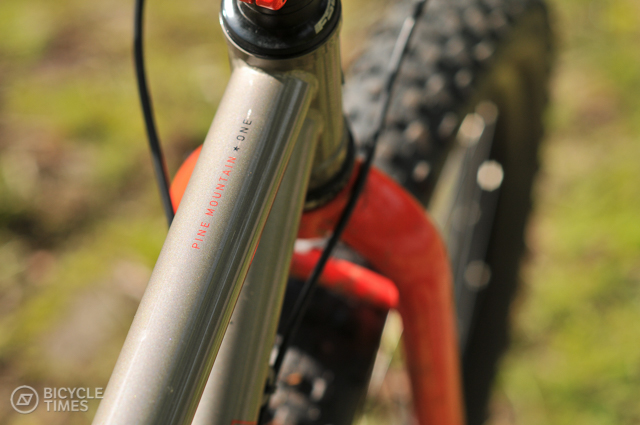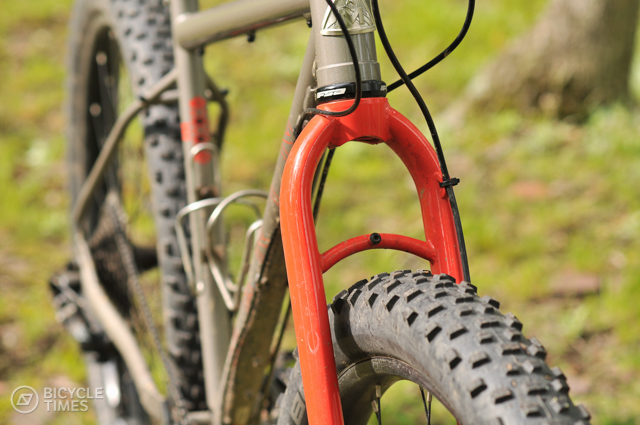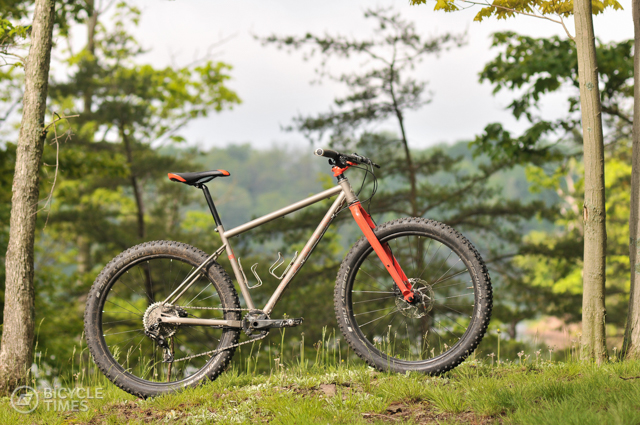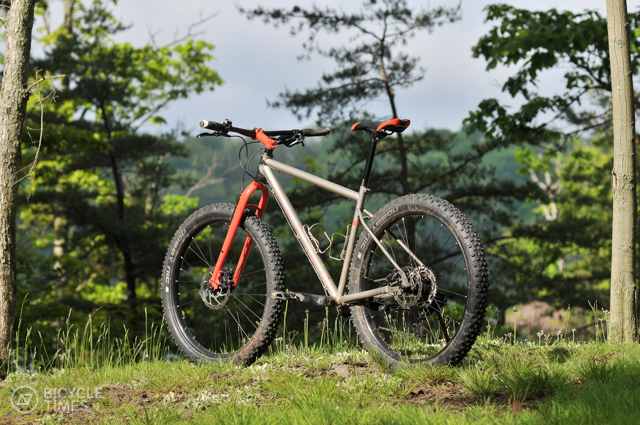Review: Marin Pine Mountain 1
Originally posted on November 2, 2016 at 9:10 amMarin reintroduced this new Pine Mountain to celebrate its 30th anniversary and it harkens back to the early days of mountain biking, when exploration and adventure were coded into the DNA of the then-emerging sport. However, this is not a throwback reproduction bike. Rather, Marin produced an adventure-ready rig with a modern geometry and plus-sized 27.5 tires.

The double-butted 4130 chromoly frame has gussets on both the top tube and down tube—a design that favors durability and stiffness over gram shaving. Weighing more than 31 pounds with pedals, nobody is going to mistake the Pine Mountain for a cross-country race bike. However, Piney was born ready for adventure.
With three water bottle mounts, rear rack/fender mounts and three bolt-on frame bag mounts on the underside of the top tube, the frame comes well-equipped for bikepacking. The flat plate chainstay yoke allows plenty of clearance for the stock 3 inch tires. One quibble: The absence of a replaceable derailleur hanger could present a problem should your derailleur tangle with a branch or rock while you’re deep, deep, deep, deep into the backcountry. I’d rather sacrifice a breakaway hanger than trash my shifty thingy.

Featuring both lowrider rack mounts and fender mounts, the suspension-corrected chromoly fork carries on the bikepacking/adventure theme. The rigid fork strikes me as “period correct” for a bike that traces its roots back to 1986. For modern-day backcountry use, a reliable, rigid fork seems like a wise choice. With no oil or air to leak out, very little could go wrong. Touch wood.
I cut my mountain biking teeth on rigid bikes almost 30 years ago, but these days I’ve succumbed to the comfort and control of suspension forks. Fortunately, my fears of a brutal beating at the hands of every root and rock proved unfounded. The 3 inch Schwalbe Nobby Nic tires rolling on wide-bodied Maddux DD40 rims provide enough cushion to take the edge off roots and fist-sized rocks. To be sure, plus-size tires are not to be confused with legit suspension. If you go crazy and plow willy-nilly into gnar-gnar this bike will remind you of its rigid nature and buck like a bronco. Cool your jets, Turbo, this ain’t no drag race.

I’d sum up Piney’s handling as well-mannered and secure, with a dash of carvy. The 69 degree head tube angle is just slack enough to feel up-to-date and non-twitchy. With its instinctive handling and wide tires, the Pine Mountain offers a sure-footed platform for any situation one might encounter. This is a great bike for explorers, or anyone who strays from perfectly groomed trails and heads for the unknown. The sketchier the trail surface, the more you’ll appreciate this secure-feeling rig. This bike claws up and over steep, loose climbs with alacrity. Don’t be afraid to dip the hip and get your lean on. Those wide tires will oblige and hook up—despite some pretty radical lean angles—even in soft conditions.

The wide tires excel at motoring on rolling terrain, where momentum is their best friend. In such conditions it helps to adopt a “singlespeeder mentality” and pre-read the terrain for opportunities to conserve and maintain momentum. The rest of the time, I’d suggest toggling out of hurry-up mode and just relax and enjoy this well-behaved bike while you explore what’s over that next hill. Who knows what you might discover, right under your nose.
It does, of course, take extra effort to keep those grippy tires turning. I felt the weight of the wheels and tires—especially on long, flat stretches or sustained climbs. Tubeless conversion shaved 230 grams per wheel, which seemed like a significant improvement, even if some of that was mental.

The 1×10 drivetrain mates a Sunrace 11-42 cassette with a narrow-wide 32-tooth chainring and shifts via a SRAM X7 derailleur and X5 shifter. Despite the fact that the 42-tooth cog is beyond the rear derailleur’s recommended range the drivetrain performed flawlessly. The 380 percent gear range made easy work of multi-hour rides over hilly terrain. I didn’t try riding with a bikepacking kit, but unless you’re heading for very steep hills with large loads, I would not worry about switching to a smaller chainring. (It is worth noting that a 30-tooth is the smallest chainring that will fit on the bike’s 104 BCD four-bolt crank).
When I let ‘er rip, the Shimano BR-M445 hydros had ample power to keep the party in bounds. They felt a little “wooden” compared to the higher-end Shimano brakes that offer superior modulation and feedback at the lever, but that was a minor issue.

Functionally, the quick-release hubs (100/135 mm F/R) worked fine—still they struck me as throwback technology on a bike with a lot of new-wave vibe. When I asked Marin’s brand director why the bike didn’t have thru-axles, he told me that using open dropouts and QR hubs allowed Marin to meet a sub-$1,000 price without making compromises elsewhere (e.g., Shimano hydros versus cable-actuated discs). Regardless, I think the Pine Mountain packs a lot of bang for the buck.
The Pine Mountain 1 strikes me as a solid value for the plus-curious rider. For the would-be bikepacker, the nice price leaves some budgetary wiggle-room for purchasing the requisite set of bags or racks. Newbie mountain bikers buyer will discover that Piney inspires confidence and has the chops to grow right along with their skill set. Happy birthday, Marin. Party on.
Vital stats
- Price: $989
- Weight: 30.6 lbs. w/o pedals
- Sizes: S, M, L (tested), XL, XXL
- marinbikes.com
